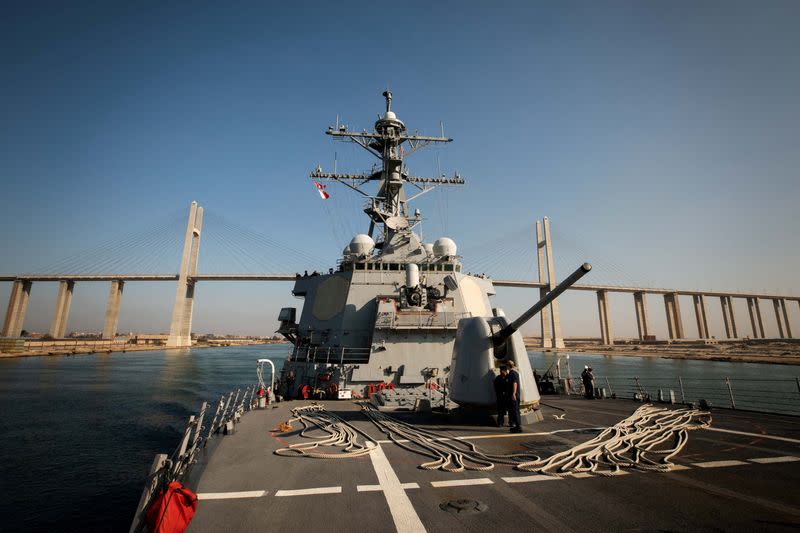How are the Red Sea attacks impacting shipping in the Suez Canal?

By Ahmad Ghaddar
LONDON (Reuters) -Attacks launched by Yemen's Houthi group on commercial ships at the southern end of the Red Sea have prompted several shipping companies to divert vessels, avoiding a route that would take them through Egypt's Suez Canal in the north and its link to the Mediterranean Sea.
The Iran-aligned group says the aim of the attacks is to support the Palestinians as Israel and Hamas wage war.
The re-routing adds cost and time to vessel journeys. Oil prices and war risk insurance premiums have spiked as a result.
WHAT IS THE SUEZ CANAL?
* The 192-km (120-mile) Suez Canal is the quickest sea route between Asia and Europe.
* The canal is one of seven geographic choke points that are critically important to the world oil trade and are also susceptible to blockages or pirate attacks.
* About 9.2 million barrels per day of oil flowed through the canal in the first half of 2023, representing about 9% of global demand, the U.S. Energy Information Administration said, quoting Vortexa data.
* Around 4% of global LNG imports estimated at 391 million metric tons in 2023 so far passed through the canal, consultancy Energy Aspects said.
* Revenue from tolls paid by shipowners is an important source of income to the Egyptian economy, and hit a record $9.4 billion in the year to June 30.
* The canal can accommodate over 60% of the total world fleet of tankers when fully loaded, and over 90% of bulk carriers. It can also accommodate all container carriers, car carriers and general cargo ships.
* A ship carrying Saudi crude from the Mideast Gulf can make it to Rotterdam, for example, in 6,436 nautical miles if it traverses the canal. Going around Africa increases the journey to 11,169 nautical miles, adding time and cost to a shipowner.
WHAT'S THE IMPACT ON CANAL NAVIGATION SO FAR?
* On Dec. 17, the Suez Canal Authority (SCA) said that since Nov. 19, 55 ships have rerouted via the Cape of Good Hope, while 2,128 have passed through the canal in the same period.
* Two major freight firms including MSC, the world's biggest container shipping line, said on Saturday they would avoid the Suez Canal as Houthi militants stepped up their assaults.
* SCA Chairman Osama Rabie said that on Dec. 17, 77 ships passed through the canal, including some ships belonging to shipping lines that had announced temporary diversions. Those were vessels that were already in the Red Sea region before the announcements were made.
* On Dec. 18 oil major BP also temporarily paused all transits through the Red Sea.
A BRIEF HISTORY
* The first canal was dug under the reign of Senausret III, Pharaoh of Egypt (1887-1849 BCE) linking the Mediterranean and Red Seas via the river Nile and its branches.
* Connecting the Mediterranean Sea with the Gulf of Suez and the Red Sea, a new artificial waterway was planned by French engineer Ferdinand de Lesseps. It took 10 years to complete and opened in November 1869.
* The canal separates the African continent from Asia, and provides the shortest maritime route between Europe and the lands lying around the Indian and western Pacific oceans. It is one of the world's most heavily used shipping lanes.
* Egypt nationalised the canal in 1956, prompting shareholders Britain and France, along with Israel, to invade. The "Suez Crisis" only ended after Egypt sank 40 ships in the canal and the United States, Soviet Union and United Nations intervened, forcing Britain, France and Israel to withdraw.
* In June 1967, Egypt and some other Arab states fought Israel in what became known as the Six-Day War, with Israeli troops advancing to the east bank of the Suez Canal before a ceasefire was agreed. The canal was very badly damaged in fighting and, with opposing forces encamped on either side, remained closed until after the 1973 Yom Kippur war.
* Egypt regained full control of the canal following the Yom Kippur war and it was reopened in June 1975.
Sources: Reuters/EIA/Suez Canal Authority/Energy Aspects
(Additional reporting by Marwa RashadEditing by Edmund Blair and Hugh Lawson)
